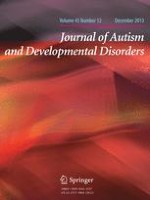01-12-2013 | Original Paper
Teacher and Child Predictors of Achieving IEP Goals of Children with Autism
Gepubliceerd in: Journal of Autism and Developmental Disorders | Uitgave 12/2013
Log in om toegang te krijgenAbstract
It is encouraging that children with autism show a strong response to early intervention, yet more research is needed for understanding the variability in responsiveness to specialized programs. Treatment predictor variables from 47 teachers and children who were randomized to receive the COMPASS intervention (Ruble et al. in The collaborative model for promoting competence and success for students with ASD. Springer, New York, 2012a) were analyzed. Predictors evaluated against child IEP goal attainment included child, teacher, intervention practice, and implementation practice variables based on an implementation science framework (Dunst and Trivette in J Soc Sci 8:143–148, 2012). Findings revealed one child (engagement), one teacher (exhaustion), two intervention quality (IEP quality for targeted and not targeted elements), and no implementation quality variables accounted for variance in child outcomes when analyzed separately. When the four significant variables were compared against each other in a single regression analysis, IEP quality accounted for one quarter of the variance in child outcomes.
